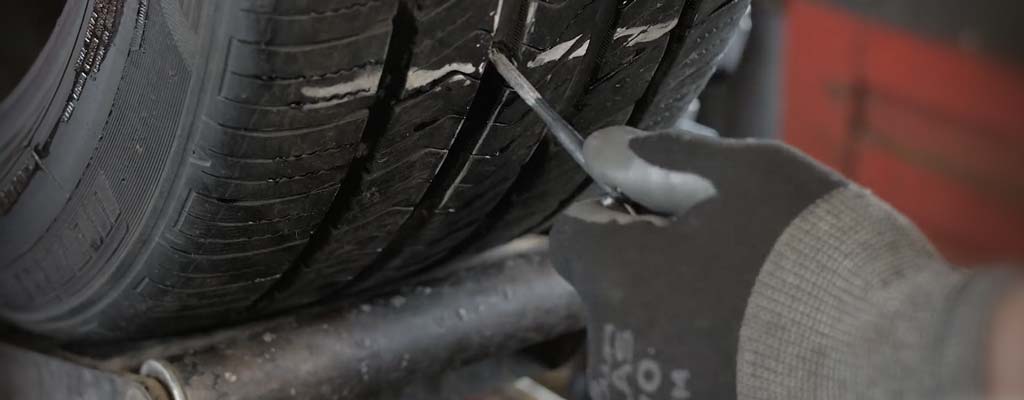Why the Combination of a Tire Plug and Patch Is Needed for Tire Repair
The roads we all drive are littered with objects and other obstacles that can cause serious tire damage. That includes curbs, rocks, potholes, glass, and nails. If you get a flat tire, it’s important the repair gets done right the first time. At Les Schwab, we fix more than a million flats every year. Here’s how we get those done with your safety and wallet in mind.
Methods Matter
Proper tire repair uses a combination of the plug and patch method (also called a hybrid or combination repair), according to the National Highway Traffic Safety Administration (NHTSA). At Les Schwab, we follow NHTSA guidelines and always repair tires using a plug-and-patch combination to ensure your safety.
What is a Tire Plug?
There are three main types of tire repair options. The first is a tire plug. After removing the object (nail, screw, other) and cleaning the area, a rubber plug is pulled into the hole from the inside of the tire. When done correctly on passenger cars and light trucks, this method will fill the hole. However, it is not a lasting fix as the plug can be jostled loose with each passing mile.
Another option includes a woven cord that is pushed through the hole from the outside of the tire. These are sometimes used as needed on ATVs, lawn and garden equipment, and recreational vehicles. These repairs are not recommended for highway use.
What is a Tire Patch?
A tire patch uses an adhesive backing or cement on a special piece of rubber to cover the damage from the inside of the tire. Without the addition of a plug repair, a patch can quickly fail when water, weather, and other debris loosen the patch. Additionally, water can get into the tire, rusting the metal belts. This can cause extensive damage.
Always Demand a Plug and Patch Repair
The Tire Industry Association, U.S. Tire Manufacturers Association (USTMA), and NHTSA all agree that safe tire repair uses both a plug and patch. When done correctly, the combination of the two types of repairs can create a strong bond that lasts for the life of the tire. That’s because the plug seals the casing and keeps moisture out of the steel belts, while the patch reinforces the injured area and keeps the plug in place.
Not All Tires Can be Repaired
While some of the other shops out there might offer to repair tires with sidewall damage or larger punctures in the tread, you could end up with an unsafe tire. The U.S. Tire Manufacturers Association, as well as the Tire Industry Association (TIA) clearly state that repairs should be limited to punctures less than ¼-inch in diameter and should never be done outside the tread area, also called the crown of the tire, to keep drivers safe on the road. This is because the sidewall and shoulder of a tire are designed to flex and give for a smooth ride. However, a patch isn't designed for that movement and will ultimately heat up and work loose. This could result in tire failure.

To ensure your safety and to help you get the most life out of your tires, we follow strict repair guidelines. We do not work on tires with damage closer than a ½-inch to the sidewall. In addition, we do not repair punctures of more than a ¼-inch on most vehicles, and ⅜-inch on light truck tires.
When you buy your tires from Les Schwab, we’ll fix any repairable flats for free using the plug-and-patch method. It’s one of the benefits of choosing Les Schwab Tires. The Les Schwab Tire Warranty includes our no-hassle road hazard protection, a 60-day satisfaction guarantee, and free tire maintenance including flat repairs, rotations, rebalancing, and air checks.
What are the Most Common Types of Tire Damage?
If you experience a flat due to damage to the tread area, including a puncture from a nail or damage from a large rock or curb, you’re not alone. Some of the most common reasons for a flat tire include nails, screws, rocks, curbs, potholes, glass, and more.
Punctures
Punctures involve nails, screws, or anything that can penetrate the tire. Most punctures result in quick or consistent loss of tire pressure.
Impacts
Impacts happen when your vehicle or tires make contact with another object. That might be another vehicle, curb, rebar, parking barrier, pothole or other structure. The impact can tear or penetrate the tread causing a flat.
Sidewall Bubbles
Sidewall bubbles are caused when you scrape along a curb or the side of the tire is impacted. This tire damage should not be repaired and the tire will need to be replaced.
Car Accidents
Car accidents can damage a tire beyond repair. If you’re in an accident, have the pros at Les Schwab visually inspect your tires before you drive too far.
Existing Repairs
Existing repairs can begin to leak or reopen with impact damage or another puncture. If new tire damage overlaps an existing repair, the tire must be replaced.
Take Care of Your Tires with Les Schwab
We fix a lot of flats every year. Every time, we start by inspecting the tire, determining if the tire can be repaired, removing the object (if there is one), cleaning the area, and then applying a plug and patch combination. The result is a repair that can last for the life of the tire.
You’ll get the Les Schwab Tire Warranty when you buy your tires from us. That includes our no-hassle road hazard protection, a 60-day satisfaction guarantee, and free tire maintenance including flat repairs, rotations, rebalancing, and air checks at any Les Schwab location.
